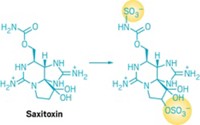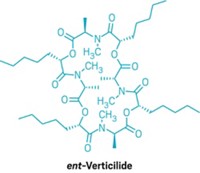Advertisement
Grab your lab coat. Let's get started
Welcome!
Welcome!
Create an account below to get 6 C&EN articles per month, receive newsletters and more - all free.
It seems this is your first time logging in online. Please enter the following information to continue.
As an ACS member you automatically get access to this site. All we need is few more details to create your reading experience.
Not you? Sign in with a different account.
Not you? Sign in with a different account.
ERROR 1
ERROR 1
ERROR 2
ERROR 2
ERROR 2
ERROR 2
ERROR 2
Password and Confirm password must match.
If you have an ACS member number, please enter it here so we can link this account to your membership. (optional)
ERROR 2
ACS values your privacy. By submitting your information, you are gaining access to C&EN and subscribing to our weekly newsletter. We use the information you provide to make your reading experience better, and we will never sell your data to third party members.
Natural Products
Synthesis of poison dart frog toxin brings surprises
Asymmetric route to batrachotoxin opens avenues for studying sodium channels
by Bethany Halford
November 17, 2016
| A version of this story appeared in
Volume 94, Issue 46

Brightly colored frogs from the Phyllobates genus hop about the Colombian rain forest without fear of being gobbled up by predators, thanks to (-)-batrachotoxin, a potent steroidal toxin in their skin. Natives of the region capture the frogs to use this toxin on the tips of blowdarts, giving the amphibians their more common name: poison dart frogs.
Toxic to the heart and nervous system, (-)-batrachotoxin is an agonist that forces open voltage-gated sodium ion channels. This property also makes the compound a useful biochemical tool for studying these channels, which are important for cardiac health and pain perception. But as Phyllobates frogs have become endangered, supplies of (-)-batrachotoxin have become scarce. Now, chemists at Stanford University report at 24-step asymmetric synthesis of (-)-batrachotoxin, giving researchers an opportunity to generate the molecule as well as novel analogs, which could be used as biological probes and, possibly, even as drugs (Science 2016, DOI: 10.1126/science.aag2981).

“Batrachotoxin is a unique chemical agent that affects channel function in a multitude of ways, and we don’t really have a great sense of how it does this at a molecular level,” says Justin Du Bois, who led the research effort that included Matthew M. Logan, Tatsuya Toma, and Rhiannon Thomas-Tran. “We’d like to be more intelligent in terms of how we design molecules that can modulate channel function,” he says, explaining that instead of simply turning the channel on, as (-)-batrachotoxin does, it would be great if one could find molecules that could tune channel function like a dimmer switch.
The synthesis developed by Du Bois’s group features a radical cascade that knits together the fused ring system. At just 24 steps, it’s quite a bit shorter than previous syntheses that took more than 40 steps. It also offers opportunities to strategically add substituents to the molecule.
Having come up with a synthesis of (-)-batrachotoxin from fairly simple building blocks, Du Bois’s group decided to also make the mirror image of the compound: (+)-batrachotoxin. To the researchers’ surprise, they discovered that although this unnatural isomer binds in the same place as the natural toxin, it has a completely different effect: It acts as an antagonist, blocking the sodium channel.
“This is a great example of how chemical synthesis can enable biological studies that would be difficult—and in the case of the unnatural isomer, impossible—to conduct with material from the natural source,” says Sarah Reisman, an expert in synthesizing natural products at Caltech.
William Catterall, an ion channel expert at the University of Washington, says the new synthesis work from Du Bois’s group “opens up outstanding opportunities to probe the voltage-dependent gating processes of sodium channels with a powerful set of new reagents and potentially to develop new sodium channel inhibitory drugs for use in therapy of cardiac arrhythmia, epilepsy, and chronic pain.”
This article has been translated into Spanish by Divulgame.org and can be found here.





Join the conversation
Contact the reporter
Submit a Letter to the Editor for publication
Engage with us on Twitter